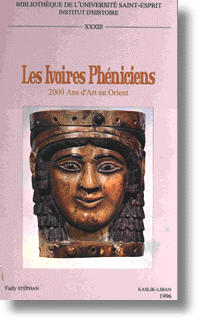d'Art en Orient By Guita G. Hourani

Les Ivoires Phéniciens: 2000 Ans d'Art en Orient. By Fady Stéphan. Bibliothèque de l'Université Saint-Esprit, Institut d'Histoire, XXXIII, Kaslik-Liban, 1996, 266 pages. Les Ivoires Phéniciens: 2000 Ans d'Art en Orient (The Phoenician Ivories: 2000 Years of Art in the Orient), is a book in French about the Phoenician ivories. It is the second book that the Holy Spirit University, in Kaslik, Lebanon has published in the field of Phoenician studies. The first was Grammaire Phénicienne by Albartus van den Branden, 1969. The Phoenicians, a Semitic race, are in fact the Canaanites who, about 7,000 years ago, inhabited the area now known as Lebanon and Syria. Some of their main cities were Tyre, Sidon, Arqad, Aradus, Byblos, Berytus, and Ugarit. Their main colonies were Carthage (in Tunisia), Malta, Sicily, Sardinia, Corsica, the Balearic Isles, Cyprus, and Gades (in Spain). The Phoenician people mystified historians and archaeologists for although they had developed the first alphabet, they left so few written records of their history. We have learned much of what we know about this enigmatic people from the writings of other people who came in contact with them. The other source of information is the archaeological diggings, especially in Byblos. Among the discoveries that teach us about the Phoenicians are the artifacts made of ivory. The Phoenicians were great artists of luxury items fashioned from ivory. They imported the raw material of animal tusks from Egypt, Africa and India. The book Les Ivoires Phéniciens: 2000 Ans d'Art en Orient gives a condensed, analytical, and informative view of the ivories of Byblos, Sidon, Beisan, Kamid El-Loz, Ugarit, Megiddo, Saqqara, Samarie, Arslan-Tash, Karlsruhe, Khorsabad, Nimroud, and Ur, among others. Besides the ivories, the author describes the sites and the archaeological excavations; the techniques, influences, and the motifs; and the inscriptions on the artifacts. The book reveals the craftsmanship, artistic genius, and exquisite taste of this bygone celebrated civilization. According to Les Ivoires Phéniciens, the Phoenician ivories discovered in Egypt, Malta, Cyprus, Carthage, Spain, Turkey, Syria, Lebanon, and other places include female accessories such as cosmetic implements, boxes, combs, and handles for fans; decorative, artistic and sacred items such as human and animal figurines, mythological creatures, plant life; ceremonial or hunting scenes and soldiers on march; and furniture such as thrones, chairs, beds. Some of these items are embellished with enamel, gold leaf, or inlaid stones, all of which enhance their beauty and worth. Among the most impressive pieces are the birth of Horus, the Sun God of Egypt; the Sphinx; a statue of the Queen of Ugarit who has been called "the Mona Lisa of Nimroud"; and the bed headboards of Hazaël in Arslan-Tash and of Salamine in Cyprus. Some of the worked ivory pieces were signed with the names of the artist or owner in Phoenician, Aramaic, Greek and Cypriot syllabic. The author concludes that because the Phoenicians placed their own personal and distinct flair in ivory design, art historians are able to recognize their work anywhere. This is an absorbing and valuable reference work for those interested in Phoenician studies, the ancient Near East, early art and commerce. To order this and other books published by the Holy Spirit University in Kaslik, please write to: USEK Publication
For further reading on the Phoenicians, please consult the following references: Aubet, M.E. The Phoenicians and the West: Politics, Colonies and Trade, Mary Turton (Translator), Cambridge: Cambridge University Press, 1993. Barnett, Richard. D. Ancient Ivories in the Middle East and Adjacent Countries. Jerusalem: Institute of Archaeology, Hebrew University of Jerusalem, 1982. |